
Banksia meisneri, commonly known as Meisner's banksia, is a shrub that is endemic to a small area in the south-west of Western Australia. It has crowded, more or less linear leaves and in winter and spring, spikes of golden brown flowers followed by furry fruit which usually only open after fire.
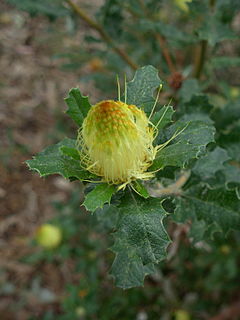
Banksia undata, commonly known as urchin dryandra, is a species of shrub that is endemic to the southwest of Western Australia. It has sessile, wedge-shaped, wavy, serrated leaves, pale yellow flowers in heads of between 80 and 160, and later up to eight follicles in each head.
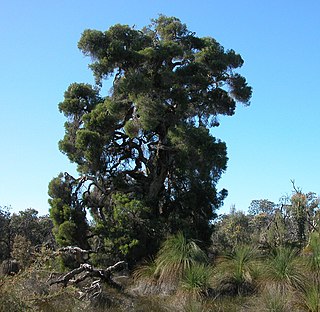
Melaleuca preissiana, commonly known as stout paperbark, modong or moonah, is a plant in the myrtle family, Myrtaceae and is endemic to coastal areas of southwest Australia. It is a shrub or small tree with papery bark, small leaves and spikes of usually white flowers. It occurs chiefly in areas that are seasonally wet.
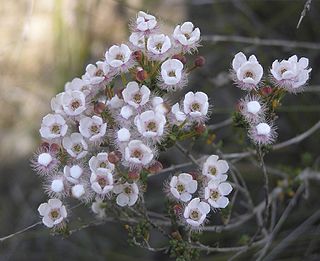
Verticordia habrantha, commonly known as hidden featherflower, is a flowering plant in the myrtle family, Myrtaceae and is endemic to the south-west of Western Australia. It is a slender shrub with short, leafy side-branches and long flowering stems with rounded heads of mostly white flowers. Its hairy sepals are mostly hidden by the round, unfringed petals, and as a result, the plant looks like shrubs in the genus Chamelaucium, to which it is closely related.
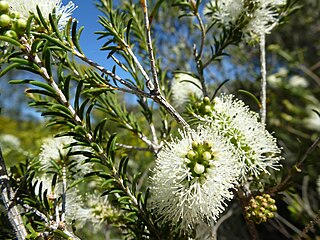
Melaleuca rhaphiophylla, commonly known as swamp paperbark is a plant in the myrtle family, Myrtaceae and is endemic to the south west of Western Australia. It has narrow, needle-like leaves and profuse spikes of white or yellowish flowers at variable times throughout the year. As its common name suggests, it is usually found in salt marshes, or swamps or along watercourses and occurs over wide areas of the south-west.
Melaleuca villosisepala is a shrub in the myrtle family Myrtaceae and is endemic to the south-west of Western Australia. It is a shrub with narrow leaves, heads of pink to mauve flowers that fade to white and is similar to Melaleuca wonganensis except that its heads of flowers are smaller and pinkish rather than deep purple.

Melaleuca violacea is a plant in the myrtle family Myrtaceae and is endemic to a small area in the south-west of Western Australia. It is a small, straggly, prostrate to semi-prostrate shrub with purple flowers and star-shaped fruit.

Melaleuca leptospermoides is a plant in the myrtle family, Myrtaceae and is endemic to a small area in the south-west of Western Australia. It is an erect shrub with narrow leaves, pinkish or purple flowers and small fruit, and is similar to Melaleuca tuberculata except that it lacks brown bracts at the base of the flowers.

Melaleuca glaberrima is a plant in the myrtle family, Myrtaceae and is endemic to the south-west of Western Australia. It is a dense, spreading shrub with needle shaped, but not sharp leaves and profuse pink or mauve flowers.

Melaleuca holosericea is a plant in the myrtle family Myrtaceae which is endemic to the south-west of Western Australia. It is a small, rare shrub similar to other pink-flowered species in the Melaleuca scabra group.
Melaleuca manglesii is a plant in the myrtle family Myrtaceae and is endemic to a small area in the south-west of Western Australia. It is a low, spreading shrub which produces large numbers of heads of purple flowers with yellow tips in spring.

Melaleuca micromera, commonly known as wattle honey-myrtle, is a plant in the myrtle family Myrtaceae and is endemic to a small area in the south-west of Western Australia. It is a rare species with unusual foliage and profuse small yellow flowerheads, making it a plant that is suitable for cultivation, if only to protect it from extinction.
Melaleuca ochroma is a plant in the myrtle family, Myrtaceae, and is endemic to the south-west of Western Australia. It is very similar to Melaleuca subfalcata, varying mainly in the length of its stamens and styles. Like M. subfalcata, it has pink to mauve flowers and leaves that are very hairy when young but become glabrous when mature.

Melaleuca pentagona is a plant in the myrtle family Myrtaceae and is endemic to the south of Western Australia. It is a showy, medium-sized shrub which produces large numbers of pink flowers in spring. There are three varieties recognised, one of which has been known in cultivation for many years.

Melaleuca spathulata is a shrub in the myrtle family, Myrtaceae, and is endemic to the south-west of Western Australia. It is a well known garden shrub featuring dark green leaves against light-coloured foliage, many twisted branches and profuse heads of bright pink "pom pom" flower heads in spring or early summer.
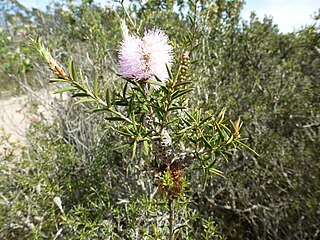
Melaleuca striata is a plant in the myrtle family, Myrtaceae, and is endemic to the south of Western Australia. It has distinctive leaves and heads of pink to mauve flowers, usually in late summer.

Melaleuca suberosa, commonly known as corky-bark honey-myrtle or corky honeymyrtle, is a shrub in the myrtle family, Myrtaceae, and is endemic to the south of Western Australia. It is a distinctive shrub, recognised by its tiny, crowded leaves, corky bark and pink flowers that appear along lengths of leafless parts of the branches.

Melaleuca subtrigona is a plant in the myrtle family, Myrtaceae, and is endemic to the south-west of Western Australia. It is a small shrub with warty leaves and heads of "pom-pom" flowers in spring and early summer.

Beaufortia empetrifolia, commonly known as south coast beaufortia, is a plant in the myrtle family, Myrtaceae and is endemic to the south-west of Western Australia. It is a highly branched shrub with small, crowded leaves and pinkish to purple flowers in small, bottlebrush-like spikes in the warmer months. It is similar to Beaufortia micrantha except that its leaves are slightly larger.
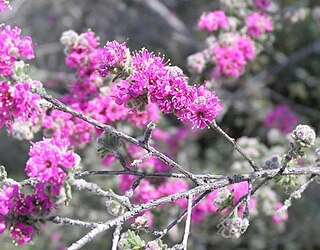
Kunzea preissiana is a flowering plant in the myrtle family, Myrtaceae, and is endemic to the southwest of Western Australia. It is a shrub with hairy branches and leaves, pink to mauve flowers in groups on the ends of shoots, and twenty to thirty stamens about the same length as the petals. It is a widespread, often locally common species across its range.


















